Dear Reader, in this age of AI created content, please support with your goodwill someone who works harder to provide the human-made. Sign up in the righthand column or bottom of this page. You will receive my hand illustrated monthly newsletter RESTORE NATURE and access to the biodiversity garden design course as I write...and nothing else, I respect your time.
Garden paths and garden paving
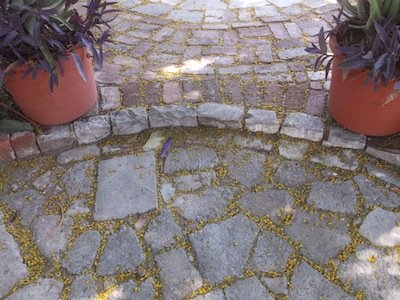 recycled garden paving and pots
recycled garden paving and potsGarden paths provide access to certain areas, tracing the people movement through the garden. They are thus likely to become compacted and there are two approaches to solving this problem. Either surfacing them with hard material to restrict the compaction to the narrow confines of the path, or surfacing them with thick mulch, so that they do not become as compacted.
Paved areas have many uses, mainly protecting earth in very well used areas from becoming exposed, eroded and dry. A paved area can provide a hard garden surface for chairs and tables in entertainment areas, and they can make a neat area in parts of the garden where plants just will not thrive, such as in the root circle of an acacia tree. They also give the garden a hard structure, a patterned element to serve as a frame for your plantings, and they form a strong design element. For some beautiful pins, go to the bottom of this page.
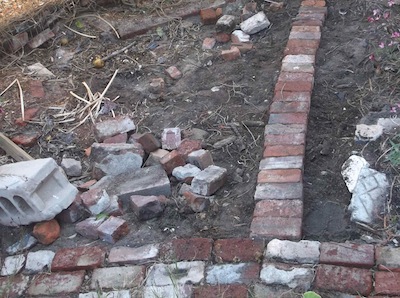 building the simplest of garden paths
building the simplest of garden paths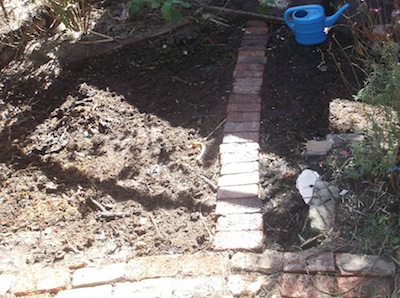
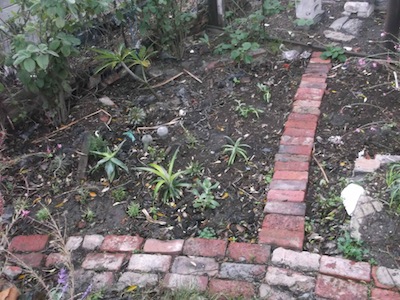
Planning garden paths
When laying garden paths hard or soft one must think carefully about access to various areas of the garden, provided by the paths. Is the path placed naturally, along the easiest route to a destination so that feet will not be tempted to wander into the beds. Do the paths harmonize with land use. Are the wide paths appropriately laid in the areas with the most traffic and the largest items being moved. A weeding path in a vegetable bed can be small, perhaps just a few stepping stones, but a path along which you are wheeling wheelbarrows, carrying buckets and so forth, and a path which you use for such activities many times a day, needs to be bigger, so that you don’t have to watch your feet so closely and don’t stumble over edgings etc.
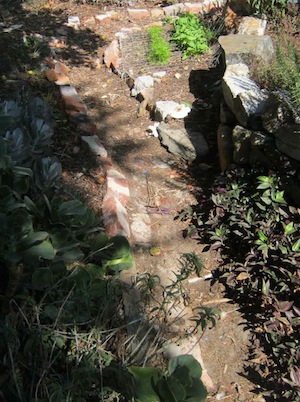 a soft mulch path meanders through the vegetable garden
a soft mulch path meanders through the vegetable gardenSoft or hard garden paths ?
Both hard and soft surfaces for paths protect the soil underneath from drying out, but insects such as ground beetles can live in the organic mulch, and these insects are good for your garden eco system. Apparently some insects also like to live in paving.
Soft paths are convenient because they can also be loosened up and moved with less effort, if the garden layout should change.
One can have the best of both worlds, both restricting the area which becomes compacted and having mulched garden paths, if the paths are edged. I use mulch paths in my vegetable gardening areas, and line them with a row of broken bricks or a plank to encourage feet to stay on the path.
I found that very long straight planks are troublesome for edging garden paths. If you knock against one end, the other swings out and gets in your way. They have to be anchored well. I’ve seen gardens where these edging planks are held in place with big wooden pegs or steel rods to give raised beds.
As organic edging for garden paths, cut branches tend to find a more stable position their irregular shapes fit into, and stay there. Some permaculturists line paths with logs from tree-felling operations. In time they will rot and become hosts for all kinds of creatures, from earwigs to fungi, adding biodiversity and useful organisms to the garden.
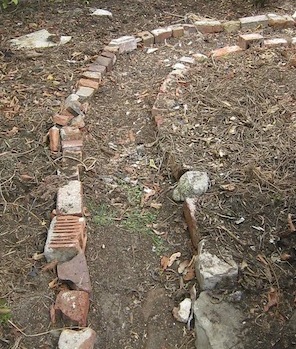 the simple completely mobile mulched path
the simple completely mobile mulched pathHow I integrated soft and hard paths in my garden functionally
My vegetable gardens lie beyond some plantings of succulents and decorative plants. I’m not saying it’s the best way of doing things, to hide your veggies, but I came to vegetable gardening later.
The access paths from the house through the succulents to the vegetable growing areas along the fence are paved, because I’m up and down them really often, watering, carrying buckets and watering cans, hanging the washing, and wheeling wheelbarrows.
The hard paths may give access to the vegetable garden, but then the vegetable garden itself is subdivided with soft organic paths. Slowly feeding the soil in the area. I used chopped up olive branches, and the pale leaves look lovely next to the rich dark brown of the compost in the beds.
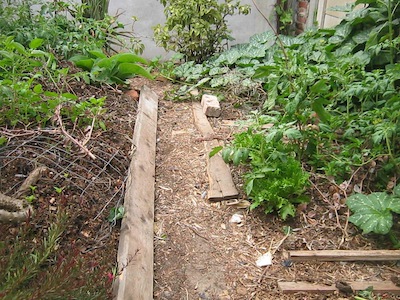 mulched garden paths edged with planks and veggies
mulched garden paths edged with planks and veggiesGarden paving:
why one would use it
I now come to paving. In my garden there are concrete slabs, from a previous owner, around the house. Areas of brick paving had been laid around the ponds by my husband many years before.
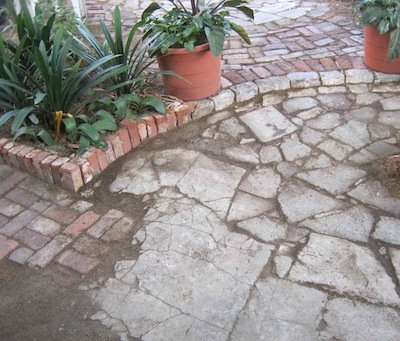 old cracked concrete slabs transition into cement shatter paving
old cracked concrete slabs transition into cement shatter pavingI found the need to integrate the very ugly cast concrete slabs around the house. The garden sloped upward, to the bricks circling the old pond site. I integrated the slabs and the bricks and the level difference by placing large broken pieces of concrete slab from the dump next to the cast concrete slabs left in situ. This way the colours blended and softened the ugly shape of the concrete surrounding the house. The concrete shatter then transitioned into the brick paving by using a difference in levels, edged with recycled cobbles in the walkway, and bricks placed upright as an edging for the future Clivia bed.
I eventually paved most of the area under the Acacia karoo, as the tree seems to suck all the nutrients and water from the area, shade it out and carpet it with fine leaves which have an inhibiting effect on the growth of other plants. The small beds in the shade, planted with Clivias mainly, are neither thriving nor suffering. However the wild iris on the sunny side, normally a vigorous grower, hardly seems to have moved in a year, other indigenous plants have pined and left this world. Even some hardy indigenous plectranthus and Pelargoniums just can’t thrive in the Acacia’s root zone. Some plants in pots from aloes with purple wandering jew, to Philodendrons, have thrived in the acacia’s shade. However it was too dark for the tomatoes, strawberries, and lemon grass.
But I digress into the topic of planting in the shade under trees. I also paved this area under the tree as it was the hub of movement in the garden, and after surfacing it became an area for working outdoors, having meals, drinking tea, swinging and entertaining. The greatest compliment I got was from someone who said eating in the shade of the thorn tree reminded him of his home in Sudan. It does indeed feel very right, dining beneath its umbrella of green.
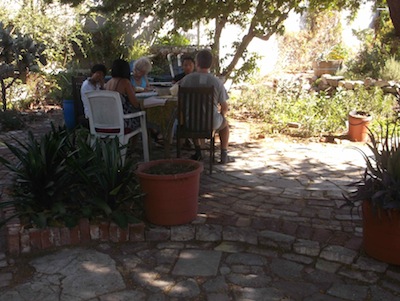 Old friends enjoying German waffles on Stephan's birthday.
Old friends enjoying German waffles on Stephan's birthday.Another reason I paved so much of my garden is because in this dry area of the world, I think it is more eco friendly than grass, and we need working surfaces, as this garden is an outdoor workshop. My husband is continually circling the ponds with buckets or nets, carrying heavy things from the worm bins to the packaging area and doing drilling and other manufacturing activities at the tables under the tree.
There is another reason this area is paved. When I took over the garden it had four plastic blue portapools in it and I had to garden around them. When the pools moved out, I paved the areas they had been with circles of a different paving colour. The ponds could be moved back any day onto these paved areas should my husband take up fish breeding again.
I recommend that whatever you do in the garden, you let it brew and the answer will come to you. Creative solutions take time. Eventually everything will integrate, you will be able to work around everyone’s needs. It just takes some rumination.
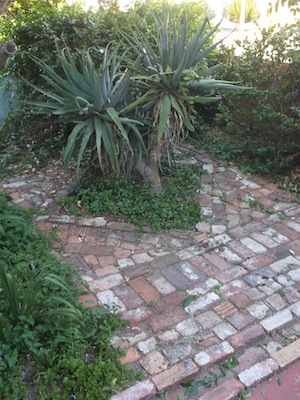 a diamond in a square, and old recycled bricks
a diamond in a square, and old recycled bricksWorking with the geometry and design of garden paving
The circles of grey cement shatter in the framework of the garden don’t sit as well as I’d like, but I had to compromise. I think a more rectilinear sequence of forms in gray cement that echoed the surrounding concrete walls would have been more aesthetially pleasing and sophisticated in the long run, but this could not be done. I didn’t start with a clean slate.
 Our work table with the matured garden paths and paving
Our work table with the matured garden paths and pavingUsing recycled materials for garden paths and garden paving
I tried to use recycled materials for the paving. All the bricks and the broken cement chunks were retrieved from our regional dumping area for builders rubble and garden refuse. You can see how the bricks are discoloured by mortar. Apparently one can clean it off with acid, as discussed on another page. I selected each piece by hand and carted it home in the trailer. Getting the material was a time consuming part of the job, about eight two hour sessions, but it was worth it, because I used other people’s discards, and it cost me nothing except petrol and time.
 building garden paving: the circle concrete shatter
building garden paving: the circle concrete shatter
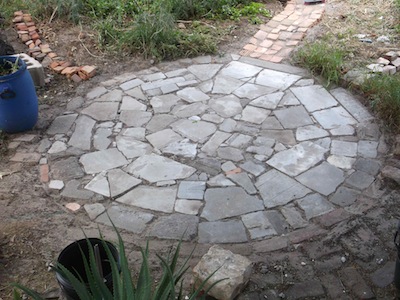 concrete shatter garden paving, brick paths being built
concrete shatter garden paving, brick paths being builtLaying the garden paths and paving the easy way
Laying the paving is quick and easy. Just level the sandy garden soil, or lay a carpet of sand. Clay could work, but it needs to be fine grained and dry. Place the paving on the surface or dig it in to get the level you want, ideally it could be slightly above the level of the garden soil so that it doesn’t wash back onto the path continually. I often dig away about 4 cm of soil, flatten the area. Place the bricks and then cover them with the soil again, sifting it as I go and sweeping it into the cracks. That is all that is required. It is the same method I use for brick paths. If the paving is of uneven thickness, and sticks out, just remove that piece, dig it deeper than the others, and then slowly lever it out with a trowel or a flat spike, till it is perfectly level with the other paving. After sweeping the dust into the cracks water it in, and go !
This can be done months later again, as the paving settles. You can sort out any paving pieces which turn into toe stubbers by taking them down a bit, or bringing up surrounding pieces.
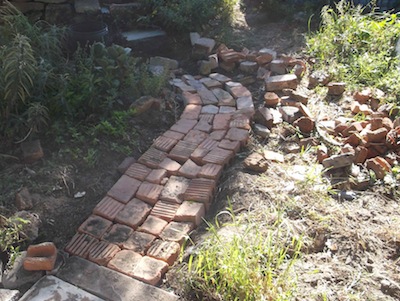 building garden paths
building garden paths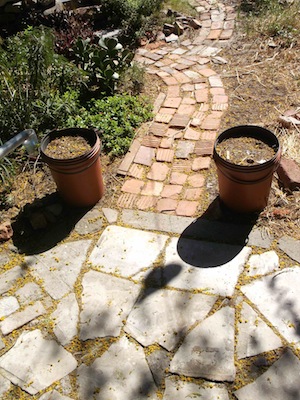 finished path from concrete circle to veggie garden
finished path from concrete circle to veggie gardenMaking impenetrable surfaces
If you want nothing to come up between the pieces of paving, you can embed them in concrete, or if its gravel you can put in a black plastic under sheet, as can be seen poking through in the picture here.
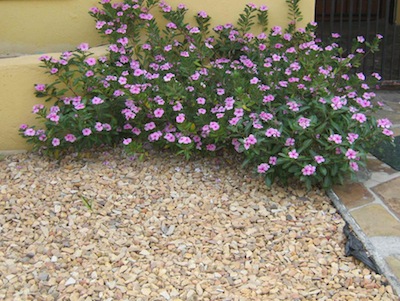 gravel with its black plastic sheeting showing
gravel with its black plastic sheeting showingI do not think it is such a good idea from the permacultural point of view as these surfaces are not water permeable and don't allow the rain to sink into the soil. Too much impenetrable paving dries out the soil in the whole area and causes flash flooding. I've seen that the storm water drains cannot cope with the runoff in heavy rains as so many people have made their gardens impenetrable to rain. it comes boiling out of the sewers in the parking lot of the supermarket.
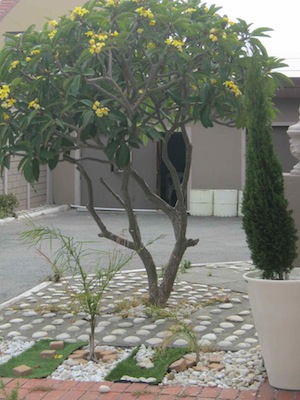 water and weed impenetrable paving embedded in concrete
water and weed impenetrable paving embedded in concrete------
home page for links to useful natural gardening topics
------
natural garden design, what you need to know to go
------
a collection of beautiful, innovative paths and paving
------
more information on path building with bricks
You’re a home gardener ! Share your experiences and questions !
We all know about home gardening. Tell us about your successes, challenges and ask about issues that bother you. You may have the luxury of a back garden, but there are other ways we learn. Few people age without growing something or buying vegetables during their lives ! It is absolutely guaranteed that you have learned things which can help others on their gardening journey.
We invite you to share your stories, ask questions, because if a thing has bothered you it will bother others too. Someone may have a solution ! No question is too small. There is learning for everyone involved, for you, for me (yes, I learn from every question), for us all. Exciting stuff !
We are starting on a new journey. Every week we will profile your letters ! The best stories and questions we receive.
What Other Visitors Have Said
Click below to see contributions from other visitors to this page...
Tips on path building from an expert with a large garden 




I found these tips for path building in a lovely book by Heidi Gilldemeister on Mediterranean Gardens.
Keep paths as horizontal as possible to stop soil …
Restore Nature Newsletter
I've been writing for four years now and I would love to hear from you
Please let me know if you have any questions, comments or stories to share on gardening, permaculture, regenerative agriculture, food forests, natural gardening, do nothing gardening, observations about pests and diseases, foraging, dealing with and using weeds constructively, composting and going offgrid.
SEARCH
Order the Kindle E-book for the SPECIAL PRICE of only
Prices valid till 30.09.2023
Recent Articles
-
Geography Research Task
Jan 31, 25 11:37 PM
To whom it may concern My name is Tanyaradzwa Madziwa and I am a matric student at Springfield Convent School. As part of our geography syllabus for this -
Eco Long Drop Pit Latrines Uganda
Nov 29, 24 02:45 AM
Good evening from the UK. My name is Murray Kirkham and I am the chairman of the International and foundation committee of my local Lindum Lincoln Rotary -
Landscape Architect
Oct 01, 24 10:42 AM
I so appreciate your informative description! Your experimentation and curiosity with the seeds, germination, and rearing of the maggot are exciting to
"How to start a profitable worm business on a shoestring budget
Order a printed copy from "Amazon" at the SPECIAL PRICE of only
or a digital version from the "Kindle" store at the SPECIAL PRICE of only
Prices valid till 30.09.2023






